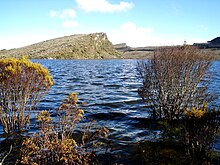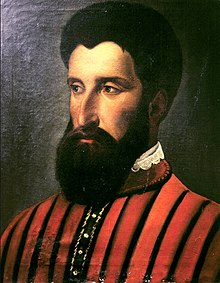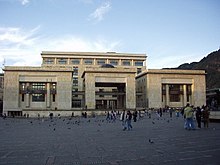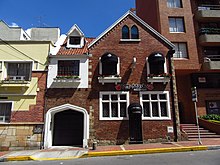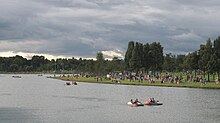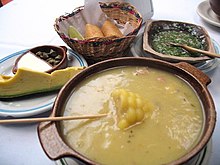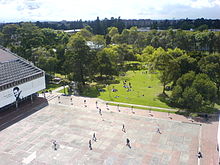Bogotá
| Bogotá, DC Bogotá |
|||
|---|---|---|---|
|
|
|||
| Coordinates | 4 ° 36 ′ N , 74 ° 5 ′ W | ||

|
|||
| Symbols | |||
|
|||
| Basic data | |||
| Country | Colombia | ||
| Bogotá | |||
| ISO 3166-2 | CO-DC | ||
| height | 2640 m | ||
| surface | 1587 km² | ||
| Metropolitan area | 4321 km² | ||
| resident | 7,412,566 (2018) | ||
| Metropolitan area | 7,881,156 (2005) | ||
| density | 4,670.8 Ew. / km² | ||
| Metropolitan area | 1,823.9 Ew. / km² | ||
| Telephone code | 00571 | ||
| Website | www.bogota.gov.co | ||
| politics | |||
| Mayor | Claudia López (2020-2023) | ||
| Others | |||
| Official structure | 20 districts (localidades) + capital district | ||
Bogotá [ bo̞ɰo̞ˈta̠ ] (officially Bogotá, Distrito Capital , Bogotá, DC for short ) is the capital of Colombia and the administrative center of the Cundinamarca Department . With 7.4 million inhabitants (as of 2018) in the actual urban area and 10.7 (as of April 2019) million in the agglomeration , Bogotá is the largest urban agglomeration in Colombia and also one of the fastest growing metropolises in South America ; In 2015 it was ranked 32nd in the list of the largest metropolitan regions in the world .
The greater Bogotá area forms the so-called capital district ( Distrito Capital , DC for short ), which is directly subordinate to the central government and thus has a special status comparable to that of Washington, DC in the USA . The city is a traffic junction and the most important economic and cultural center of the country with universities , colleges, museums and monuments.
Surname
The name Bogotá comes from the local word Bacatá . This was the name of the capital of the Zipa Confederation of the Muisca civilization. The area where the city is located today was known as Muequetá .
Bogotá has undergone a number of name changes:
- The place was also known as Thybzacá or Teusacá . This is where the name of today's Teusaquillo district came from .
- When Jiménez de Quesada founded a military base there in 1538, he gave the place the name Nuestra Señora de la Esperanza .
- When the company was founded in 1539, the name was changed to Santafé or Santa Fe . The name Santafé de Bogotá was not known at first, but it caught on to distinguish the city from the multitude of other Santafés. Funza was known as Bogotá during colonial times .
- After independence from Spain and the establishment of the republic, the capital was named Bogotá and the former Bogotá became Funza .
- The constitution of Colombia, which was renewed in 1991, gave the city the official name of Santafé de Bogotá .
- After a reform of the constitution in 2000, however , the part Santafé was deleted again and the name was shortened to Bogotá .
geography
Geographical location
The city is located in the fertile Cundiboyacense plateau of the Andes , the Sabana de Bogotá , 2640 meters above sea level , at the foot of the two Cordillera Mountains Guadalupe (3317 meters) and the Monserrate (3152 meters).
The area of the city is 1775.98 square kilometers. Of these, 384.3 square kilometers (21.64 percent) are urban areas ( área urbana ) and 1,391.68 square kilometers (78.36 percent) are rural, predominantly mountainous areas. The metropolitan region (Spanish Área Metropolitana ) has an area of 4321 square kilometers and includes Bogotá 22 other municipalities ( municipios ) in the vicinity of the capital.
Several rivers and streams wind through the city, including the San Francisco River , which joins the Río Funza (now known as Río Bogotá ) to the southwest . The Funza River is known both for its 145 meter high waterfall, the Tequendama , and for its extreme pollution. The vicinity of the city is characterized by pastures and mountain forests.
Bogotá borders in the south on the municipalities of Guamal , Cubarral and La Uribe in the Departamento del Meta and Colombia in the Departamento del Huila , in the north on Chía , in the west on Cota , Funza , Mosquera , Soacha , Pasca , San Bernardo , Arbeláez and Cabrera and to the east at La Calera , Chipaque , Choachí , Gutiérrez , Ubaque and Une (all in the department of Cundinamarca ).
The Suesca Lake is 60 km away.
geology
The capital is located in the Colombian Andes. These show a characteristic division into three cordillera: west, central and east cordillera. Between them, in continuation of the smaller high basins of the southern part, slide deep longitudinal sinks that are drained by the Río Magdalena and Río Cauca .
In their upper section, these rivers are accompanied by the partly still volcanic cordilleras, the foothills of which they have to break through in narrow valleys; in the lower reaches they run through broad lowlands. If the high valleys are the centers of settlement in the south, the more fragmented mountains further north. The most important districts for the economy of the country with the state capital Bogotá are also located here. The main product in this area is coffee. The height structure allows the cultivation of a wide variety of crops.
Since the city is located on the tectonic plate of South America , it also experiences earthquakes every now and then . These and some fires in 1785, 1827, 1917 and 1948 meant that most of the buildings from the colonial era are no longer preserved.
City structure

On June 23, 1861, the first district around the capital, the Distrito Federal de Bogotá , was created, so that the city could become the residence of the federal government of what was then the United States of Colombia . The borders were the rivers Arzobispo (to the north), Fucha (to the south), Bogotá (to the west) and the Cerros Orientales (to the east). However, the district was abolished in 1864 and then reassigned to the sovereign state of Cundinamarca.
In 1905 the territorial division of Colombia was reorganized and with Law No. 17 of April 11th, the district was reintroduced with the name Distrito Capital de Bogotá. This division was abolished in 1910, the district dissolved again and became a municipality in Cundinamarca again . Ordinance 3640 of December 17, 1954 created the District of Bogotá (Distrito Especial de Bogotá), which came into force on January 1, 1955 under President Gustavo Rojas Pinilla.
By decree No. 7 of the Board of Directors of Cundinamarca, the municipalities of Bosa, Engativa, Fontibon, Suba, Usaquén and Usme and Sumapaz became municipalities of the city. These retain partial autonomy and in the following years mayor offices arise, including Chapinero, in which the first subordinate mayor of the city is introduced. Puente Aranda followed in 1964 and Ciudad Kennedy in 1967. Five years later the district was divided into 16 smaller parishes. New mayor's offices are emerging in the three traditional sectors of the center: Santafé, Teusaquillo and Los Mártires; the districts of Unidos del Norte, Antonio Nariño, San Cristóbal and Tunjuelito, divided by Usme. In 1977 the mayor's office of La Candelaria was created and in 1983, due to the land occupation in the south, the government launched the Ciudad Bolivar plan and became a municipality with it.
The new constitution of 1991 changed the special district ( distrito especial ) into today's capital district ( distrito capital ). The communities thus became localities / districts. Since then, Bogotá has been divided into 20 districts ( localidades ):
|
climate
Colombia is located in the tropical climate zone . However, because of the high altitude above sea level (over 2600 m), Bogotá has a temperate climate with an average annual temperature of 13.3 degrees Celsius. Since Bogotá is close to the equator , there are no major seasonal differences. The climate is characterized by trade winds .
The annual maximum temperature averages 16.0 degrees Celsius, the average annual minimum temperature 7.4 degrees Celsius. The temperatures rarely exceed the limit of 23 degrees Celsius and can even reach freezing point on cloudless nights. In January 2007 record temperatures of −8.1 degrees Celsius were measured in the city and −10.8 degrees Celsius in the metropolitan area.
The average annual rainfall is 799 millimeters. Most of the precipitation falls in the months of April and October with an average of 101 to 107 millimeters, the least in January with an average of 29 millimeters. Rainfall falls on an average of 185 days a year.
| Bogotá | ||||||||||||||||||||||||||||||||||||||||||||||||
|---|---|---|---|---|---|---|---|---|---|---|---|---|---|---|---|---|---|---|---|---|---|---|---|---|---|---|---|---|---|---|---|---|---|---|---|---|---|---|---|---|---|---|---|---|---|---|---|---|
| Climate diagram | ||||||||||||||||||||||||||||||||||||||||||||||||
| ||||||||||||||||||||||||||||||||||||||||||||||||
|
Average monthly temperatures and rainfall for Bogotá
Source: IDEAM
|
|||||||||||||||||||||||||||||||||||||||||||||||||||||||||||||||||||||||||||||||||||||||||||||||||||||||||
story
City foundation
Bogotá was officially re-founded by Gonzalo Jiménez de Quesada on August 6, 1538 on the site of the Chibcha town of Bacatá (high field) . He gave it the name Santa Fe, named after his hometown Santa Fe near the Spanish city of Granada . Shortly afterwards, de Bogotá , derived from the original Indian Bacatá , was added, so that the final name of the city was Santa Fe de Bogotá .
In the same year another Spanish expedition under Sebastián de Belalcázar , the new founder of Quito , and from the east a third expedition under the Wels captain Nikolaus Federmann from Augsburg reached the Chibcha empire and the Bogotá plateau . They claimed rights, but received only one settlement from Quesada and left the newly founded city. Quesada founded the city formally and legally in April 1539 with Nikolaus Federmann and Sebastián de Belalcázar.
Colonial Era and Republican Era
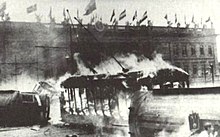
In the colonial times, Bogotá was the capital of New Granada . Together with Cartagena de Indias , it was the most important city in what is now Colombia . In 1801 Alexander von Humboldt visited the biologist José Celestino Mutis in Bogotá.
Among other things, through the influence of the influential Creoles living in the city, the Colombian independence movement emerged there, which achieved the first secession from Spain on July 20, 1810 . The Spaniards were able to recapture the territories; Colombia was not finally independent until 1819.
In the same year Bogotá became the capital of Greater Colombia , which in 1830 was divided into today's Ecuador , Colombia (with the capital Bogotá) and Venezuela . The city was ravaged by several civil wars over the next few decades . The most influential war of this time was the Guerra de los Mil Dias (War of the Thousand Days, 1899–1902) between the conservative and liberal parties.
The first half of the 20th century
In 1905 the city had 100,000 inhabitants. In the 20th century, Bogotá grew not only in terms of population, but also in terms of culture, so that it became known as the " Athens of South America". The Organization of American States was founded in Bogotá in 1948 ; this event was bloody interrupted on April 9, 1948 by the murder of the popular presidential candidate of the Liberal Party, Jorge Eliécer Gaitán .
That was the occasion for the so-called Bogotazo, a wave of violence that lasted several days. The city was plundered by angry crowds. At that time, the future Cuban head of state, Fidel Castro, lived in Bogotá.
After the Bogotazo, the city developed significantly differently. The wealthy families who had previously lived in the city center moved to other parts of the city or nearby places such as Chapinero , El Chicó and Usaquen, mostly in the north of the city.
The 1950s and 1960s
In the aftermath of the Bogotazo, Colombia went through wave after wave of violence. This led to the capital becoming a haven for displaced people. It grew from less than half a million to more than seven million inhabitants in the 20th century.
During the military dictatorship from 1953 onwards, the city was expanded to the west, mainly due to the fact that the international airport Aeropuerto Internacional El Dorado was built at that time, and that the city could no longer expand further east due to the natural border of the mountains . On January 1, 1955, the suburbs of Bosa, Engativa, Fontibon, Suba, Usme and Usaquén were incorporated into Bogotá and the Distrito Especial was founded within the province of Cundinamarca . The short dictatorship was replaced in 1957 by an institutionalized coalition between liberal and conservative parties, the so-called Frente Nacional (National Front) .
In 1961, US President John F. Kennedy visited the city as part of the Alliance for Progress program . The aim of this was to bring the Latin American members of the Organization of American States closer to the USA , as they did not like the Soviet influence in these states. This visit resulted in one of the largest districts of Bogotá, Ciudad Kennedy, which now has a population of more than a million.
The 1970s and 1980s
In the 1970s, the M-19 guerrilla group was founded and helped shape the future of the city and the country. The government decided to build the Casa de Nariño , the seat of the president, which was a common example of luxury in the middle of the impoverished city center for the time. On April 30, 1984, Justice Minister Rodrigo Lara Bonilla was murdered by the drug mafia in the north of the city. This fact led to the confrontation between the state and the cartels of drug trafficking throughout the country.
November 6, 1985 became the most tragic day in the history of the city since Bogotazo. The M-19 guerrilla group took the Palace of Justice in Bogotá. The ensuing clashes and the recapture by the state power killed several hundred people. On November 13, 1985, the Nevado del Ruiz volcano erupted and its snow cap melted from the heat. This caused the Lagunilla River to overflow its banks, and the town of Armero was buried under tons of mud. Thousands of people perished in the floods of mud. Bogotá became a new home for many of the survivors of the disaster.
Four people were killed in a pilot suicide in August 1979.
The development since 1990
On July 5, 1991, when the suburb of Sumapaz was incorporated into Bogotá, the Distrito Especial was renamed Distrito Capital and it was spun off from the province of Cundinamarca. In the 1990s, Bogotá became a target for drug cartels. Many terrorist attacks were carried out in the city, including bombs in shopping centers and the main building of the "DAS" (the State Security Service). Hundreds of bystanders were killed in these attacks and the drug war deepened. That decade sealed the state's security services with the death of drug lord Gonzalo Rodríguez Gacha , aka the Mexican .
After the dissolution of the M-19 by its leader Carlos Pizarro Leóngomez , the latter stood for election as a presidential candidate, but was murdered during a scheduled flight. The city then changed under the influence of the mayors Jaime Castro , Antanas Mockus and Enrique Peñalosa . In 2000 the construction of the TransMilenio started. In the same year Antanas Mockus became mayor of the city for the second time, followed by Eduardo Garzon , who took office as the first socialist mayor of Bogotá in 2003.
population
Population development
Bogotá is growing rapidly and the slums on its fringes are constantly expanding. In 1951 the city still had 715,000 inhabitants, by 2018 the number had increased more than tenfold to 7.4 million. The rural exodus of the population is enormous. To avoid poverty in the countryside, many farmers move to the capital in the hope of finding a job and better living conditions there.
A metropolis that emerged from a mixture of influences from the indigenous people, the Spaniards and the English, and just as varied and multi-faceted: around 68 percent of the population are mestizos , 20 percent white, around ten percent black Africans, mulattos and zambos , only two percent Indigenous people. Over 90 percent of the population is Catholic. Slightly more than 2.4 percent of the population aged 15 and over are illiterate (over eight percent in the rest of the country), with 95.5 percent of the population under the age of eight having a school education.
The following overview shows the number of inhabitants according to the respective territorial status. All data are estimates from national institutes and statistical offices as well as census results. The population figures refer to the actual city without the suburban belt.

| Population development | |||||||||||||||||||||||||||||||||||||||||||||||||||||
|---|---|---|---|---|---|---|---|---|---|---|---|---|---|---|---|---|---|---|---|---|---|---|---|---|---|---|---|---|---|---|---|---|---|---|---|---|---|---|---|---|---|---|---|---|---|---|---|---|---|---|---|---|---|
|
|
||||||||||||||||||||||||||||||||||||||||||||||||||||
Social situation of the population
Bogotá is a victim of the population movement from the rural area towards the city due to the civil war that has been going on for decades. Added to this is the persistently poor economic situation since the 1990s. This resulted in numerous slums on the periphery , in which a large part of the population now lives. In terms of urban planning, these are marginal settlements . Many of the older settlements are currently in a process of gradual consolidation, despite the lack of important infrastructure (e.g. tap water).
The political and economic development is reflected in the city's increased poverty rates . This is also evident in the cityscape. Also near the center there are slums with high rates of drug use and crime, for example the “El Bronx” area. At many traffic lights you can see beggars and sellers. The residential areas in the north of the city are considered to be posh and rich, the districts in the south as insecure and poor. Bogotá also has high unemployment, and the proportion of the population who cannot afford the necessary food rose from just under seven percent in 1997 to 14.9 percent in 2000.
| Percentage of people or households whose income is below the specified basic shopping cart | |||||
|---|---|---|---|---|---|
| 1997 | 1998 | 1999 | 2000 | 2013 | |
| Colombia | 51.53 | 50.9 | 53.8 | 59.8 | 30.6 |
| Bogotá | 35.08 | 36.57 | 43.5 | 49.6 | 10.2 |
Religions and worldviews
Bogotá is the seat of a Roman Catholic archbishop. In 2003 Pope John Paul II established three suffragan dioceses from the territory of the Archdiocese of Bogotá , which are also located in the city: Engativá , Fontibón and Soacha . The most important church in the city is the cathedral of the archbishopric, the Catedral Basílica Metropolitana de la Inmaculada Concepción de Bogotá .
The Pentecostal movement is particularly widespread among the evangelical currents .
politics
City government
The city government of Bogotá ( Alcaldía de Bogotá ) consists of the Lord Mayor ( Alcalde Mayor ) and a 45-member city council ( Concejo de Bogotá ). These are elected for four years.
The city governments of the last decade have been increasingly concerned with improving the social situation, community life and infrastructure in the capital.
Antanas Mockus , who was mayor from 1995 to 1996 and 2001 to 2003, formed a city government that consisted of academics rather than politicians in the most important posts. He rehabilitated the capital's finances by only releasing funds when they were actually made available. Although many of his methods were unpopular, such as fuel taxation, he won over citizens. Through the ban on pyrotechnics, but above all through the La hora zanahoria social project (a kind of curfew ), he achieved a reduction in the high number of deaths. The hora zanahoria proved to be its most popular scheme. He became known abroad through the measure to use pantomimes to educate motorists to comply with the road traffic regulations. His campaign to voluntarily save water was also successful.
In the city council and mayoral elections on October 26, 2003, the candidate of the left-wing collective movement Independent Democratic Pole (Polo Democratico Independiente, PDI), Luis Eduardo Garzón (nicknamed Lucho ) won. He is a former oil workers union activist and a co-founder of the PDI. With around 47 percent of the vote, he won against the journalist Juan Lozano (supported by President Álvaro Uribe Vélez ). This received 40 percent of the vote.
In the regional elections in 2007, a politician of the Polo Democrático was again able to prevail. Samuel Moreno Rojas won the election with 43.7 percent of the vote. Enrique Peñalosa, supported by the right-wing President Uribe, achieved 28.15 percent. Moreno took over the office of mayor from Luis Eduardo Garzón on January 1st, 2008. Moreno was removed from office in May 2011 on massive corruption charges.
From the beginning of 2016 to the end of 2019, Enrique Peñalosa from Equipo por Bogotá and Cambio Radical was mayor of Bogotá. He was succeeded by Claudia López Hernández on January 1, 2020 . She won the mayoral election for Alianza Verde on October 27, 2019 .
Town twinning
Bogotá has partnerships with the following cities:
|
|
|
Organizations, institutions
Culture and sights
theatre
The capital's theaters offer a variety of ballet, opera and theatrical performances, as well as musical performances. Well-known orchestras in the city are the Orquesta Sinfónica Nacional de Colombia, the Orquesta Filarmónica de Bogotá and the symphonic wind orchestra "Santafé de Bogotá". The most important theaters in Bogotá include the Teatro Nacional (National Theater), the Teatro "Jorge Eliécer Gaitán" (Theater of the City of Bogotá), the Teatro Colón (Columbus Theater) and the Teatro "La Candelaria".
In particular, the “La Candelaria” theater, directed by Santiago García, shaped the “Creación Colectiva” principle on the Latin American continent, in which the actors develop a play and its staging in a collective process. This working method was developed with the intention of creating an independent form and history of theater from the rejection of the dominance of cultural influences in Europe and North America.
Museums
Bogotá offers over 58 museums and 62 galleries. In addition to the National Museum and the Museo de Arte Colonial , the Museo del Oro , which opened in 1938, is one of the most important museums in the city. With 38,000 exhibits, it houses the world's most important collection of pre-Columbian gold art. In a 360-degree shop window, several thousand golden suns, plants and animal figures that glow in the dark are embedded in artificial landscapes. Many of the exhibits come from the so-called Eldorado lagoon of Guatavita . There the conquistadors found numerous animal species made of gold in 1560: monkeys, fish, toads and also a caiman .
The museum in the monastery of Santa Clara is also interesting. The old church of the Poor Clares , built between 1619 and 1630 in the style of the late Renaissance, is an almost unadorned building on the outside, but inside it is equipped with a lavish baroque splendor: gilded high altars, paintings by the local baroque painter Baltazar de Figueroa (1580–1667) and Gregorio Vázquez de Arce y Ceballos (1638–1711) and above it a vaulted ceiling made of luminous gold leaf ornaments.
In addition to a large number of works by Fernando Botero , the Museo Botero also shows works by other artists such as Pablo Picasso , Joan Miró , Edgar Degas and Claude Monet . Other important museums in Bogotá are the Museo de Arte Moderno de Bogotá , the Museo Nacional de Colombia , the Museo de Arte Colonial , the Quinta de Bolívar , the Museo de los Niños de Bogotá and the Museo de Arte de la Universidad Nacional de Colombia .
Buildings
Bogotá is traditionally an important center for art and culture in northern South America . La Candelaria, the old town of Bogotá, with its historical buildings and squares, is of historical, cultural and tourist value. There are many public buildings and churches around Plaza Bolívar . The cultural life was decisively shaped by three major Catholic orders - the Dominicans , Franciscans and the Jesuits . These three orders also shaped urban architecture by building numerous churches and monasteries.
The monumental Plaza Bolívar is dominated by three large building complexes: the classicist cathedral completed in 1823 with the attached "Capilla del Sagrario", the "Capitolio Nacional" with a mighty portico and the "Alcaldía de Bogotá". Both palaces are built in the classicism style, the latter clearly showing the French influence. On the nearby Monserrate Hill is the Monserrate Shrine.
The concrete building of the Palace of Justice, which occupies the north side of Plaza Bolívar, is a reminder that dramatic scenes took place there in 1985. Because the former Palace of Justice was occupied by guerrillas in a spectacular operation , who holed up there with several hostages, whereupon the palace was so shot that a new building was built on the same spot.
Behind the Archbishop's Palace on Calle 10 is the baroque Jesuit church of San Ignacio. The church, built at the beginning of the 17th century according to plans by the architect Juan Bautista Colochini, has a three-aisled interior with various frescoes and gilded altars. Today the "Museo de Arte Colonial" has been set up in the rooms of the nearby Jesuit monastery.
The San Francisco Church, completed in 1594, is also worth seeing. It was built in a typical, mixed Sevillian style between Mudéjar and Renaissance and later changed to Baroque style. Inside there is a semicircular high altar, built in 1622, which occupies the entire choir and above it a wood-carved roof vault in Mudejar style. The church houses several paintings by the Spanish baroque painter Francisco de Zurbarán (1598–1664) and the local painter Gregorio Vasquez de Arce y Ceballos, a student of the son of Bartolomé Esteban Murillo (1617–1682), who emigrated to Bogotá.
In addition to parks and bike paths, Bogotá has also built new and large libraries and renovated or rebuilt countless public buildings and schools. At the 2006 Venice Architecture Biennale, the city was awarded the Golden Lion for its efforts to make itself more livable.
In Zipaquirá , 25 kilometers north of Bogotá, there is a unique underground salt cathedral in the Sabana de Bogotá , one of the largest in the world.
Parks
Worth seeing are the Simón Bolívar Park ( Parque Metropolitano Simón Bolívar ), one of the largest urban parks in the world, the Botanical Garden (Jardín Botánico) with the seat of the Coldeportes Ministry of Sports and the National Park (Parque Nacional), the site of numerous cultural events.
In El Tunal -Park every summer are organized festivals of Latin American rock music and the Parque del Chicó there is a built in a colonial style museum. Other significant parks in Bogotá are Parque Sauzalito, Parque La Florida, Parque San Andrés, Parque Tunal, Parque Timiza and Parque Tercer Milenio.
Outside the city, the Salto del Tequendama (Tequendama Waterfall ), which plunges down through a rocky canyon into the Andes jungle 145 meters below, is worth a visit . About 30 kilometers northeast of the city center is Lake Guatavita .
The place used to be a center of religious ceremonies of the Muisca Indians, in which gold was the focus and which, according to tradition, are the origin of the legend of " Eldorado ". Various gold objects and precious stones were sacrificed to the sun god in the mountain lake there. The Spanish conquistadors tried to drain the lake in 1560 and cut a V-shaped entrance into the rim of the crater. The attempt was unsuccessful, however.
About 20 km south of Bogotá is the Parque Natural de Chicaque , located between 2720 m and 2100 m altitude, with an area of about 300 hectares . A system of hiking trails with a total length of around 15 km runs through this nature park, which is located in the so-called cloud forest zone , high above the north bank of the Río Bogotá .
Pedestrian zones
Since September 2006, Calles 10a and 11 from Carrera 3a to 10a have only been open to pedestrians from 9 a.m. to 7 p.m. This means that 43 buildings and monuments on this route have become particularly attractive for tourists. These streets belong to the old town center and are therefore shaped by the Spanish architecture.
Sports
Bogotá has achieved international fame in the field of sports primarily with its two football clubs , Millonarios , fourteen-time Colombian football champions, and Santa Fe , seven-time champions. The home stadium of the two clubs is the Estadio Nemesio Camacho ("El Campín") , which opened in 1938 and has a capacity of around 40,000 seats. Another club in the first division is La Equidad , which plays its home games at the Estadio Metropolitano de Techo in the south of the city.
The Bogotá half marathon has been taking place at the end of July and beginning of August since 2000 , in which not only international elite athletes take part, but also over 40,000 popular runners.
The racing driver Juan Pablo Montoya , who was born in Bogotá, has achieved international recognition with his successes, especially in the USA and Germany. He achieved successes i.a. in the CART Championship Series , the 500 miles from Indianapolis in Formula 1 .
The final of the Staircase World Cup has been held in Bogotá every year since 2009 at the beginning of December .
In the city's parks and public sports facilities, people can be seen practicing many sports, such as indoor soccer, volleyball, basketball, and skateboarding.
Ciclovía
Since 1976 the city has organized a Ciclovía (Spanish for bicycle path) every Sunday and public holiday . For this purpose, from 7:00 a.m. to 2:00 p.m., over 120 km of the road network in 18 of the 20 city districts will be closed to motorized traffic. Every week over two million people take part in the Ciclovía on foot, on bicycles or on inline skates.
The Ciclovía has been anchored in law since the 1980s and it is being organized more professionally from year to year: conscripts have been used to secure the intersections since 1995, a large part of the route is cordoned off with road signs, and detours are made for motorized traffic signposted. In addition, the city offers free aerobics events and information points at some central nodes . As of August 13, 2006, participants can use 74 public toilets along the route. In addition, there are now veterinarians at some of the 600 information points, where drinks and food are also offered.
Regular events
Festivals
Numerous events take place in the city, among which the following are particularly popular with visitors: -
The Temporada Taurina is the bullfighting season. It is celebrated in the Plaza de Toros La Santamaría (bullring) in January and February . It is next to the Independence Park ( Parque de la Independencia ). The most important bullfighters from Latin America and Europe come to Bogotá for this occasion.
The Festival de Rock al Parque is an annual music festival. It is considered to be the largest of its kind in the Spanish language worldwide. The genres that are played are as varied as the audience; from metal, hardcore, punk, ska to blues and jazz to alternative. It takes place in the large event hall of the Parque Metropolitano Simón Bolívar , which can accommodate up to 250,000 visitors.
The Festival de Salsa al Parque takes place in Parque Simón Bolívar . The best salsa orchestras from New York , Cuba , Puerto Rico , Colombia and the Caribbean take part.
The Festival de Jazz al Parque is a jazz festival that takes place in September each year in the city's largest parks and university campuses.
The Festival Internacional de Cine (since 1984) is an international film festival and is also held annually. It was originally specialized in Colombian films and is now a major international festival for new directors.
The Iberoamericano de Teatro festival is culturally one of the most important events in the city and attracts theater groups from all over the world. It takes place every other year in March or April, so it falls on Easter week.
The Carnaval de Bogotá is held every year on August 6th to celebrate the founding of the city.
Measure
Exhibitions and fairs can be found almost every week. The most important are:
The Feria Internacional del Libro is a book fair that takes place every year on the Corferias grounds .
The Feria Internacional de Bogotá is the largest trade fair in Colombia and is used to display industrial and consumer goods. It opens its doors every two years.
Expoartesanías is an annual handicraft fair . It is the most important fair for Colombian handicrafts and one of the most important in Latin America.
Culinary specialties
A culinary specialty of the capital is the " Ajiaco Santafereño". It is a hearty soup that consists of three different types of potatoes, chicken and corn on the cob and is seasoned with French cabbage (guasca). A small, yolk-yellow type of potato boils off completely. The soup is served with capers and fresh cream and eaten with avocado and rice. Another specialty of the region is “puchero” - a stew made from different types of meat, cabbage, potatoes, bananas and pumpkin.
The inhabitants of the city also like to eat ceviche , a dish in many variations, mostly based on marinated, raw fish.
Economy and Infrastructure
business
The city is the economic center of Colombia and is responsible for a significant part of the economic output of the entire country. According to a study from 2014, the greater Bogotá area generated a gross domestic product of 159.85 billion US dollars in purchasing power parity . In the ranking of the economically strongest metropolitan regions worldwide, it took 81st place. The GDP per capita was $ 15,497 (PPP).
Important branches of industry are printing and publishing, textile, food, metal, mechanical engineering and electrical industries. Numerous banks and companies are based in Bogotá. The city is home to approximately 100,000 sole proprietorships in all sectors. About $ 4 billion in foreign capital flows into the city as investments each year. 24 percent of the national export goods are produced in Bogotá. Over 400 multinational companies are actively doing business in Bogotá.
The majority of foreign companies in Colombia have settled in the capital, in which they partly have a monopoly. This has led to a strong concentration of industrial companies, in particular the management as well as the research and sales departments in Bogotá. The regional interdependencies of industry are also predominantly determined by the capital, so that the metropolitan area has a pronounced center-periphery relationship.
Problems are caused by the high level of air pollution caused by the pollutant emissions from industrial plants and the exhaust gases from motor vehicles (high ozone and carbon monoxide values ) as well as the density of traffic. In the industry, which is concentrated in the metropolitan area of Bogotá, there are only inadequate disposal and cleaning capacities for wastewater, exhaust gas and waste. In particular, the population in the slum settlements on the southern and western outskirts of the city is at risk from infectious diseases such as cholera , diarrhea and typhoid , which are spread through inadequate hygienic conditions. In addition, there are respiratory and skin diseases due to the toxic emissions from numerous industrial companies and car traffic.
With the Corferias exhibition center in the Teusaquillo district in the center, Bogotá has one of the largest exhibition centers in South America. The highlight is the international trade fair, which takes place every year at the beginning of October.
life quality
In a study by the Globalization and World Cities Research Group (GaWC) at Loughborough University , England , Bogotá landed in the Beta + World Cities category in 2008, along with Barcelona, Washington DC, Los Angeles, Johannesburg, Helsinki, Berlin, Dubai, Oslo, Copenhagen, Hamburg and Cairo.
The GaWC listed global cities in the economic sense based on their importance for advanced producer services, namely accounting, advertising, banking and law firms. In addition to economic criteria, cultural, political and social criteria were also taken into account to a limited extent.
In a ranking of cities according to their quality of life, Bogotá was ranked 128th out of 231 cities worldwide in 2018. Compared to other Latin American capitals, it was behind Montevideo (77th place), Buenos Aires (91st place), Santiago de Chile (92nd place), Brasília (108th place) and Lima (124th place) but still ahead of Mexico City (129th place) ) and Caracas (place 193).
traffic
Numerous roads, including the Panamericana , connect the city with other major cities. Bogotá is divided up like a chessboard. The streets are numbered after “carreras” and “calles”, with some of the major bypasses and main thoroughfares also bearing names (such as Carrera 14 - Avenida Caracas).
There is no rail-bound transport system in the city. The main load of public transport is carried by a separate network of bus roads, on which the buses of the TransMilenio system run at frequent intervals . The core of the concept is a bus rapid transit . The large buses have their own lanes and - in contrast to other bus services in Bogotá - there are clearly defined stops. Shuttle buses connect the outskirts of Bogotá to the TransMilenio stops, as does the TransMiCable cable car, which opened in 2018 .
According to current plans, the first line of the Bogotá Metro is to open in 2028. Likewise, suburban rail traffic is to be resumed from 2024 .
The first horse tram ran on December 25, 1884 in Bogota, the first electric tram on March 7, 1910. After many trams and the infrastructure of the network during the violent protests following the assassination of Jorge Eliecer Gaitán were destroyed on the holding on 30 was. Discontinued June 1951. Trolleybuses ran in the city between April 12, 1948 and August 15, 1991.
Other parts of the TransMilenio traffic concept are a newly created network of cycle paths (ciclorutas), new green spaces and pedestrian zones in the urban area and the twice-yearly car-free day. Since its introduction by the former mayor Antanas Mockus, the bicycle paths in Bogotá have grown to a length of 303 kilometers into one of the largest cycle path networks in the world. These trails stretch from north of the city (170th Street) to the south (27th Street) and from Monserrate in the east to the Bogotá River in the west.
Bogotá Airport is located around 15 kilometers northwest of the city and is served by a large number of direct scheduled flights.
education
Bogotá is the educational center of the country and is home to several universities of high standing such as the Universidad Nacional de Colombia , Universidad del Rosario, Universidad Externado de Colombia , Pontifical University of Xaveriana , Universidad de los Andes , and many other educational institutions and libraries. In 1777 the Jesuits opened America's first public library in the Palacio de San Carlos .
The Universidad Nacional de Colombia is the first public and state university in Colombia. It was founded on September 22, 1867 with six courses. Between 1903 and 1940 a further 20 courses were added and the first master’s courses were offered in 1967; In 1986 the university awarded its first doctorate.
The following universities are also located in Bogotá: Universidad de los Andes , Pontifical University Xaveriana , Universidad Santo Tomás , Universidad de la Sabana ( Opus Dei ), Universidad Distrital , Universidad Autónoma de Colombia , Universidad Pedagógica Nacional , Escuela Colombiana de Ingeniería , Universidad Central de Colombia , Universidad La Gran Colombia , Universidad Libre and Universidad Jorge Tadeo Lozano . In both historicity, the Colegio Mayor de San Bartolomé , from 1604 AD, is the oldest high school in Colombia, birthplace of the Universidad Nacional de Colombia and alma mater of several national leaders Francisco de Paula Santander , Antonio Nariño and Camilo Torres.
The universities are run both by the state and privately. Technical degrees are awarded after three years, graduates (comparable to Bachelor ) after four and diplomas after five years. In addition, master's and doctoral degrees are offered, the latter only through state-recognized institutions.
The German language is taught at the Goethe Institute as well as at the German School Colegio Andino and the Swiss School Colegio Helvetia . The German language is also offered in numerous universities and private language schools.
Bogotá was chosen by UNESCO as the “World Book Capital 2007” and this year offered a comprehensive cultural program on the subject of books, creative activities and the active participation of public and private actors in the book sector.
Personalities
The sons and daughters of the city of Bogotá include the following personalities:
Politician
- Antonio Nariño (1765-1824), politician
- Jorge Eliécer Gaitán (1903–1948), politician and lawyer
- Alberto Lleras Camargo (1906–1990), politician and two-time President of Colombia (1945–1946 and 1958–1962)
- Carlos Lleras Restrepo (1908–1994), politician and President of Colombia from 1966 to 1970
- Julio César Turbay Ayala (1916–2005), politician and President of Colombia from 1978 to 1982
- Ernesto Samper (* 1950), politician and President of Colombia from 1994 to 1998
- Juan Manuel Santos (* 1951), politician and President of Colombia since 2010
- Antanas Mockus (* 1952), philosopher, mathematician and politician and former mayor of Bogotá
- Andrés Pastrana (* 1954), politician and President of Colombia from 1998 to 2002
athlete
- Patty Dodd (* 1963), volleyball and beach volleyball player
- Fred Rodriguez (* 1973), American professional cyclist
- Juan Pablo Montoya (* 1975), Formula 1 racing driver
- Andrés Chitiva (* 1979), football player
- Andrea Galindo (* 1982), beach volleyball player
- Mariana Duque Mariño (* 1989), tennis player
- Esteban Chaves (* 1990), racing cyclist
- Sebastián Saavedra (* 1990), racing car driver
- Carlos Huertas (* 1991), racing car driver
- Egan Bernal (* 1997), racing cyclist
- Vicente Besuijen (* 2001), Dutch football player
actor
- John Leguizamo (born 1964), actor and comedian
- Catalina Sandino Moreno (* 1981), actress
Musician
- Honorio Alarcón (1859-1920), pianist
- José Joaquín Guarín (1825-1854), composer
- Santos Cifuentes (1870–1932), composer
- Guillermo Uribe Holguín (1880–1971), composer
- Rafael Puyana Michelsen (1931-2013), harpsichordist
- Andrea Echeverri (* 1965), singer
- Daniel Zamudio (1887–1952), composer
writer
- Rafael Pombo (1833–1912), writer and diplomat
- Antonio Álvarez Lleras (1892–1956), playwright
- Andrés Holguín (1918–1989), poet, translator and literary critic
- Álvaro Mutis (1923–2013), writer
scientist
- Walter Stühmer (* 1948), physicist
literature
sorted alphabetically by author
- Ricardo Adrián Vergara Durán: Programs, concepts and strategies for housing and living environment improvement in lower class neighborhoods of Santafé de Bogota / Colombia. Tectum Verlag, Marburg 2001, ISBN 3-8288-1089-6
- Claudia Cendales Paredes: "The South American Athens" - The public gardens and parks in Bogotá compared to other Latin American capitals . In: Die Gartenkunst Volume 23 (1/2011), pp. 91–120.
- Stefan Roggenbuck: Street children in Latin America. Comparative social science study: Bogotá (Colombia), Sao Paulo (Brazil) and Lima (Peru). Verlag Peter Lang, 1993, ISBN 3-631-45894-0
- Anna I. Streissler: Young people in Bogota. Brandes & Apsel, 2001, ISBN 3-86099-290-2 .
Web links
- Official website of the city of Bogotá (Spanish)
- Goethe Institute Bogotá
- Colombian National Library
- Biblored - The network of public libraries of the capital district
- Museo del Oro (English and Spanish)
- German school in Bogotá
- Katja Stemmler: Street system - explanation of the urban street system
Individual evidence
- ^ Informacion Capital
- ↑ residents bogotá - Google search. Retrieved July 3, 2019 .
- ↑ World City Populations 1950 - 2035 luminocity3d.org, accessed March 25, 2019.
- ↑ a b c Archivo de Bogotá: Apuntes de la historia de Bogotá ( Memento from June 22, 2014 in the web archive archive.today ) (Spanish)
- ↑ Historia de los terremotos en Colombia (PDF)
- ↑ Marco E. Cortés Díaz: La anexión de los 6 municipios vecinos a Bogotá en 1954 . Universidad Nacional de Colombia . P. 56. Retrieved August 9, 2011.
- ^ Atlas Geográfico e Histórico de la República de Colombia; Agustín Codazzi, Manuel María Paz y Felipe Pérez, París, 1890.
- ↑ Concepto 074 de 2003 . In: Secretaría General Alcaldía Mayor de Bogotá DC . Retrieved April 20, 2009.
- ^ Distrito Capital (Colombia) . In: Encarta . Retrieved on April 20, 2009 ( page no longer available , search in web archives )
- ↑ Instituto de Hidrología, Meteorología y Estudios Ambientales de Colombia (IDEAM): World Weather Information Service
- ^ Andreas W. Daum: Alexander von Humboldt . CH Beck, Munich 2019, ISBN 978-3-406-73435-9 , pp. 54 .
- ↑ Habitabilidad en Bogotá ( Memento of May 5, 2006 in the Internet Archive )
- ↑ PMGA-DAMA
- ↑ Estudios Censales. Colombia - Proyecciones quiquenales de población, 1950-2050. Fuente: Cálculos de la Dirección General de Planeación y Análisis de Política del MPS con base en DANE .
- ↑ El Bronx, un símbolo de abandono y desidia , eltiempo.com, accessed on April 12, 2015
- ↑ a b DNP-UDS-DIOGS, based on the statistics compiled by DANE - part of the 2000 census
- ↑ a b Pobreza Monetaria y Multidimensional 2013 (PDF; 525 kB) dane.gov.co, dated March 21, 2015
- ↑ See: Cornelia Butler Flora: Pentecostalism in Colombia: Baptism by Fire and Spirit , Cranbury, New Jersey, 1976.
- ↑ Bogotá elige la primera alcaldesa Lgbt de una capital de América . In: El Heraldo , October 27, 2019.
- ↑ Caminar por las calles 10 y 11, en el centro de Bogotá, es una experiencia para gozar ( Memento of January 6, 2007 in the Internet Archive ) (Spanish)
- ↑ Historia de la CicloVía y RecreoVía ( Memento of January 16, 2007 in the Internet Archive ) (Spanish)
- ↑ Nuevos servicios de la ciclovía inauguró el Instituto Distrital de Recreación y Deporte ( Memento of August 29, 2006 in the Internet Archive ) (Spanish)
- ^ Alan Berube, Jesus Leal Trujillo, Tao Ran, and Joseph Parilla: Global Metro Monitor . In: Brookings . January 22, 2015 ( brookings.edu [accessed July 19, 2018]).
- ^ The World According to GaWC 2008
- ↑ Mercer's 2018 Quality of Living Rankings. Retrieved August 18, 2018 .
- ↑ Jose Luis Martínez: Metro de Bogotá recibe avales por 90 millones de dólares para su construcción. City of Bogotá, June 25, 2020, accessed October 8, 2020 (Spanish).
- ↑ University website , accessed November 2017.
- ↑ UNESCO: Bogotá: World Book Capital 2007




